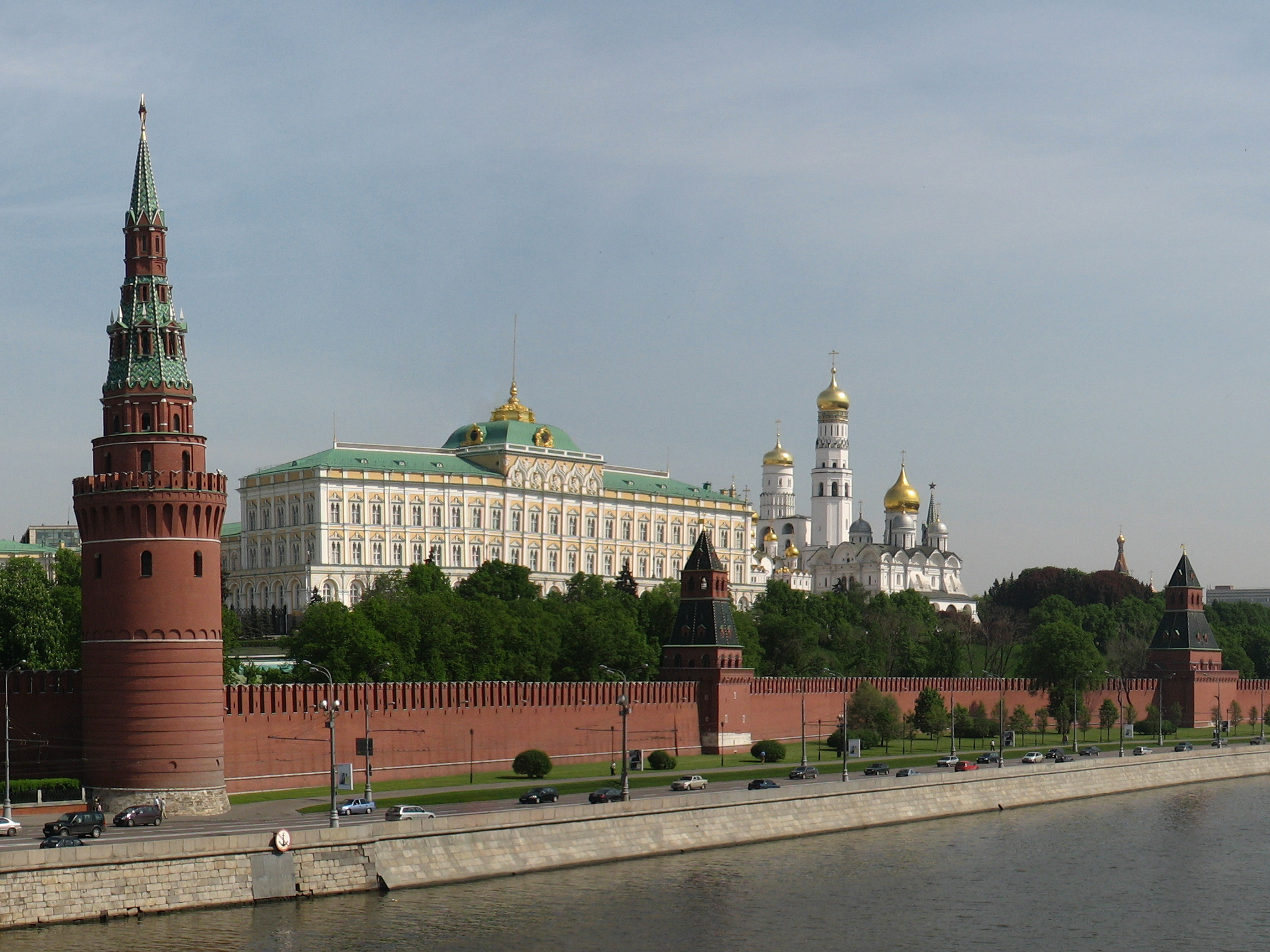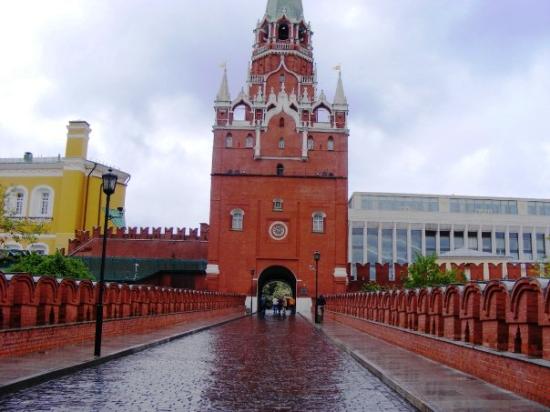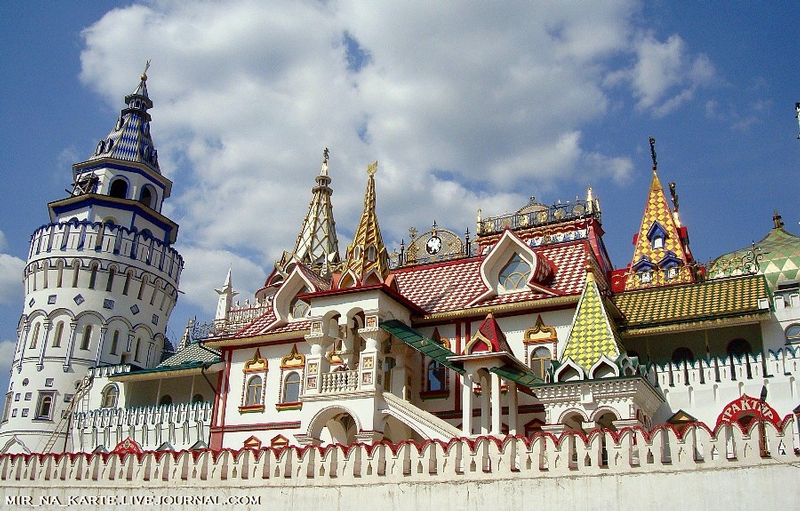THE KREMLIN
This is a real city with palaces, cathedrals, museums and, of course, the seat of government, where the tsars and communist dictators ruled. The word refers to the Kremlin citadel of a city, the Russian cities with no exterior walls of protection, it was the central place where we could take refuge in case of invasion. That Moscow was built to protect the city from the Tartars. By extension, the word Kremlin is used to name the power it contains. Thus, the Moscow Kremlin also means the Russian government. Triangular in shape, the red walls of the Kremlin in Moscow dominate the Moskva. Even before the eleventh century, the place was already fortified, but these walls there date back to the late fifteenth century. In the seventeenth century, the Kremlin lost its strategic military importance, and its towers were crowned as well as can be seen today. The Napoleonic Marshal Mortier blew the Kremlin fortress before leaving the city occupied by the French emperor in October 1812, but was restored. The Soviets have damaged the place and placed modern buildings, such as the convention center. The walls are 6 feet thick and up to 19 meters high, with a total length of 2235 meters. Twenty towers are between 20 and 70 meters high.
Inside the Kremlin, found near the cathedral:
 - The Cathedral of the Archangel
- The Cathedral of the Archangel
Built on Cathedral Square between 1505 and 1508 in a pretty Venetian style, this cathedral is the spiritual heart of historic Moscow. It was built in the place of several other religious buildings. If the stones are now white, exterior walls were once painted red. The exterior can believe she is on two floors, but that's not the case. The golden bulbs are the eighteenth century, and they replaced a dome too damaged. The interior frescoes date from the sixteenth and seventeenth centuries. It shows also an iconoclastic 13 meters high, containing paintings of the twelfth and eighteenth centuries. The necropolis is a condensed history of Russia, such as that of Saint Denis Basilica in Paris. It was originally all grand princes and tsars since Ivan I (died 1340) to Peter II (1730), to Ivan IV the Terrible. Women were buried at the Monastery of the Resurrection, but the Soviets have led their graves in this cathedral during the twentieth century.
- The Cathedral of the Annunciation
Cathedral Square also, it was built also in a style inspired by the Italian Renaissance style between 1485 and 1489, replacing a building of the fourteenth century. She "private" church of the tsars. Four domed chapels have been assistants to 1563 portals limestone are also the sixteenth. Icons from the fourteenth to the seventeenth century are contained in the iconoclast.
- The Cathedral of the Dormition
It is the oldest cathedral in Moscow (1475-1479). It replaced another church built in 1330 by Ivan I as head of the Russian Orthodox church. This is where the tsars were crowned and married (as was the case of Ivan the Terrible, then Michael III, the first Romanov). On the steps of the cathedral, Ivan III tore up the Treaty of Moscow to the Mongolian submission; what amounted to a declaration of independence from Russia. Icons, mainly seventeenth century, are remarkable. the "Dormition" of the Virgin is the equivalent of the Assumption for Catholics.
- The Palace at Facet
He was directly built by Italian architects between 1487 and 1491, and is only a small part of a larger palace replaced the meantime. It owes its name to the faces of the exterior façade. With the Terem Palace, it was built at the Grand Palais during the nineteenth century. The interior is rich in frescoes and sculptures. The great room was the throne room. Its ceiling is 500m2 and is absolutely stunning. Tsars went to the Cathedral of the Dormition through the "red stairs." The last procession was held for the coronation of Nicolas II in 1896 The staircase was rebuilt in 1994 at the same Stalin had destroyed the original in 1930.
- The Terem Palace
Dating back to 1637 this is a beautiful little building bricks, and is also ection of the Grand Palais since the nineteenth century. There are apartments of Tsar, and workshops, where such were made clothes of the royal family.
- The Church of the Deposition of the Robe of the Virgin
Completed in 1486, it was up to the seventeenth century church of metropolitans and patriarchs of Moscow.
- The palace of the Patriarch
Built between 1642 and 1655, he is topped by the church of the Twelve Apostles.
- The Church of the Twelve Apostles
Built along with the palace, it replaced an older church, and a piece of the Palace of Boris Godunov. The roof is covered with tiles of bronze or gold and is topped by five domes. In 1929, after the destruction of the convent church of Voznesensky, his iconoclastic superb seventeenth century was transported here and there still is.
- The bell tower of Ivan the Great
Belfry 81 meters high, it was built between 1505 and 1508, and enhanced in 1600 with a new dome. It is bordered by the Church of St. John of the Ladder.
Also contained within the enclosure:
The Grand Kremlin Palace
He was bati between 1837 and 1851 in order to exalt Russian power. It took a baroque palace and
destroy a church to make room for its 125 meters long and 47 high. It contains the palace and Facet Ténem, nine churches from the fourteenth, sixteenth and seventeenth centuries, more than 700 rooms, including those of the west wing, which were those of the imperial family when she was not in St. Petersburg. This wing is now used for receptions and official state ceremonies. The signatures of international treaties as seen on TV take place mostly in the Alexandravsky lobby. The Supreme Soviet organized conferences in Andreïevsky lobby.
The Armory
It dates from 1851, but an earlier existed in this location at least in 1508 it was the arms factory, but today it is a museum where you can admire all the treasures accumulated ceremonial by princes and tsars from suits to armor, to a beautiful collection of Faberge eggs and other masterpieces of jewelry, including the famous Orlov diamond.
The Palais des Menus Plaisirs
First a private royal residence built in 1652, it was converted into a palace "show and pocket money." Behind its walls colored (pink, yellow and red), some tsars received their education before it became the residence of the commander of the Kremlin.
The Arsenal
In the northeast corner of the Kremlin, it was completed in 1736 on the orders of Peter the Great and was rebuilt in the wake of Napoleon.
The Senate
It is here that Lenin chose to live. Moreover, the apartments still exist, and you can visit a museum. Note that at many places, crosses were replaced by red stars during the totalitarian era.
The Kremlin also includes the Palace of Congress and the Presidential Palace, where Russia has shaken the world during the 70 years of communism.
Source:Moscou.
More pictures of the Kremlin:











This is a real city with palaces, cathedrals, museums and, of course, the seat of government, where the tsars and communist dictators ruled. The word refers to the Kremlin citadel of a city, the Russian cities with no exterior walls of protection, it was the central place where we could take refuge in case of invasion. That Moscow was built to protect the city from the Tartars. By extension, the word Kremlin is used to name the power it contains. Thus, the Moscow Kremlin also means the Russian government. Triangular in shape, the red walls of the Kremlin in Moscow dominate the Moskva. Even before the eleventh century, the place was already fortified, but these walls there date back to the late fifteenth century. In the seventeenth century, the Kremlin lost its strategic military importance, and its towers were crowned as well as can be seen today. The Napoleonic Marshal Mortier blew the Kremlin fortress before leaving the city occupied by the French emperor in October 1812, but was restored. The Soviets have damaged the place and placed modern buildings, such as the convention center. The walls are 6 feet thick and up to 19 meters high, with a total length of 2235 meters. Twenty towers are between 20 and 70 meters high.
Inside the Kremlin, found near the cathedral:
 - The Cathedral of the Archangel
- The Cathedral of the Archangel Built on Cathedral Square between 1505 and 1508 in a pretty Venetian style, this cathedral is the spiritual heart of historic Moscow. It was built in the place of several other religious buildings. If the stones are now white, exterior walls were once painted red. The exterior can believe she is on two floors, but that's not the case. The golden bulbs are the eighteenth century, and they replaced a dome too damaged. The interior frescoes date from the sixteenth and seventeenth centuries. It shows also an iconoclastic 13 meters high, containing paintings of the twelfth and eighteenth centuries. The necropolis is a condensed history of Russia, such as that of Saint Denis Basilica in Paris. It was originally all grand princes and tsars since Ivan I (died 1340) to Peter II (1730), to Ivan IV the Terrible. Women were buried at the Monastery of the Resurrection, but the Soviets have led their graves in this cathedral during the twentieth century.
- The Cathedral of the Annunciation
Cathedral Square also, it was built also in a style inspired by the Italian Renaissance style between 1485 and 1489, replacing a building of the fourteenth century. She "private" church of the tsars. Four domed chapels have been assistants to 1563 portals limestone are also the sixteenth. Icons from the fourteenth to the seventeenth century are contained in the iconoclast.
- The Cathedral of the Dormition
It is the oldest cathedral in Moscow (1475-1479). It replaced another church built in 1330 by Ivan I as head of the Russian Orthodox church. This is where the tsars were crowned and married (as was the case of Ivan the Terrible, then Michael III, the first Romanov). On the steps of the cathedral, Ivan III tore up the Treaty of Moscow to the Mongolian submission; what amounted to a declaration of independence from Russia. Icons, mainly seventeenth century, are remarkable. the "Dormition" of the Virgin is the equivalent of the Assumption for Catholics.
- The Palace at Facet
He was directly built by Italian architects between 1487 and 1491, and is only a small part of a larger palace replaced the meantime. It owes its name to the faces of the exterior façade. With the Terem Palace, it was built at the Grand Palais during the nineteenth century. The interior is rich in frescoes and sculptures. The great room was the throne room. Its ceiling is 500m2 and is absolutely stunning. Tsars went to the Cathedral of the Dormition through the "red stairs." The last procession was held for the coronation of Nicolas II in 1896 The staircase was rebuilt in 1994 at the same Stalin had destroyed the original in 1930.
- The Terem Palace
Dating back to 1637 this is a beautiful little building bricks, and is also ection of the Grand Palais since the nineteenth century. There are apartments of Tsar, and workshops, where such were made clothes of the royal family.
- The Church of the Deposition of the Robe of the Virgin
Completed in 1486, it was up to the seventeenth century church of metropolitans and patriarchs of Moscow.
- The palace of the Patriarch
Built between 1642 and 1655, he is topped by the church of the Twelve Apostles.
- The Church of the Twelve Apostles
Built along with the palace, it replaced an older church, and a piece of the Palace of Boris Godunov. The roof is covered with tiles of bronze or gold and is topped by five domes. In 1929, after the destruction of the convent church of Voznesensky, his iconoclastic superb seventeenth century was transported here and there still is.
- The bell tower of Ivan the Great
Belfry 81 meters high, it was built between 1505 and 1508, and enhanced in 1600 with a new dome. It is bordered by the Church of St. John of the Ladder.
Also contained within the enclosure:
The Grand Kremlin Palace
He was bati between 1837 and 1851 in order to exalt Russian power. It took a baroque palace and
destroy a church to make room for its 125 meters long and 47 high. It contains the palace and Facet Ténem, nine churches from the fourteenth, sixteenth and seventeenth centuries, more than 700 rooms, including those of the west wing, which were those of the imperial family when she was not in St. Petersburg. This wing is now used for receptions and official state ceremonies. The signatures of international treaties as seen on TV take place mostly in the Alexandravsky lobby. The Supreme Soviet organized conferences in Andreïevsky lobby.
The Armory
It dates from 1851, but an earlier existed in this location at least in 1508 it was the arms factory, but today it is a museum where you can admire all the treasures accumulated ceremonial by princes and tsars from suits to armor, to a beautiful collection of Faberge eggs and other masterpieces of jewelry, including the famous Orlov diamond.
The Palais des Menus Plaisirs
First a private royal residence built in 1652, it was converted into a palace "show and pocket money." Behind its walls colored (pink, yellow and red), some tsars received their education before it became the residence of the commander of the Kremlin.
The Arsenal
In the northeast corner of the Kremlin, it was completed in 1736 on the orders of Peter the Great and was rebuilt in the wake of Napoleon.
The Senate
It is here that Lenin chose to live. Moreover, the apartments still exist, and you can visit a museum. Note that at many places, crosses were replaced by red stars during the totalitarian era.
The Kremlin also includes the Palace of Congress and the Presidential Palace, where Russia has shaken the world during the 70 years of communism.
Source:Moscou.
More pictures of the Kremlin:













No comments:
Post a Comment